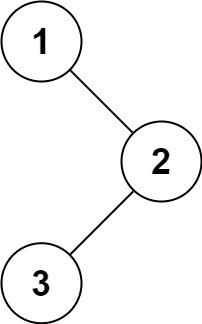144. Binary Tree Preorder Traversal #
Problem #
Given the root of a binary tree, return the preorder traversal of its nodes’ values.
Example #
Example 1: #

Input: root = [1,null,2,3]
Output: [1,2,3]
Constraints #
- The number of nodes in the tree is in the range [0, 100].
- 100 <= Node.val <= 100
Follow up #
Recursive solution is trivial, could you do it iteratively?
Approach and Intuition #
Recursive approach #
class Solution {
public List<Integer> inorderTraversal(TreeNode root) {
List<Integer> res = new ArrayList<>();
helper(root, res);
return res;
}
public void helper(TreeNode root, List<Integer> res) {
if (root != null) {
res.add(root.val);
helper(root.left, res);
helper(root.right, res);
}
}
}
Complexity Analysis #
Time complexity:
\( O(n) \)
as the recurrence relation is
\( T(n) = 2T(n/2) + 1 \)
.
Explanation #
Recurrence Relation:
Let \(T(n)\) is the number of operations executed in your traversal algorithm(DFS). Function is recursively called 2 times each time for left and right sub-tree.
\( T(n) = 2T(n/2) + 1 \) .
Using the
Masters’ Theorem , we have
\(T(n) = a*T(n/b) + f(n)\)
f(n) is some constant.
For a Graph, the complexity of a Depth First Traversal is
\( O(V + E) \)
,
where V is the number of nodes or vertices, and E is the number of edges.
A Binary Tree is also a Graph, and we visit each node only once.
The complexity of each of these Depth-first traversals(Pre, In and Post) is \(O(V + E)\) or \(O(N + E)\) .
Since the number of edges that can originate from a node is limited to 2 in the case of a Binary Tree,
the maximum number of edges in a Binary Tree is
\(n-1\)
, where n is the total number of nodes.
The complexity then becomes \(O(n + n-1)\) , which is \(O(n)\) .
As for recursion, the only difference is that recursive method calls build the stack implicitly by pushing call frames to the JVM stack
Master Theorem #
Let
\(T(n)\)
be a monotonically increasing function that satisfies:
\(T(n) = a T(n/b) + f(n)\)
\(T(1) = c\)
where
\(a >= 1, b >= 2, c>0\)
.
If
\(f(n)\)
is
\(\Theta(n^d)\)
where
\(d >= 0\)
then
\(
x = \begin{cases}
a &\text{if } b \\
c &\text{if } d
\end{cases}
\)
Space Complexity:
\( O(1) \)
